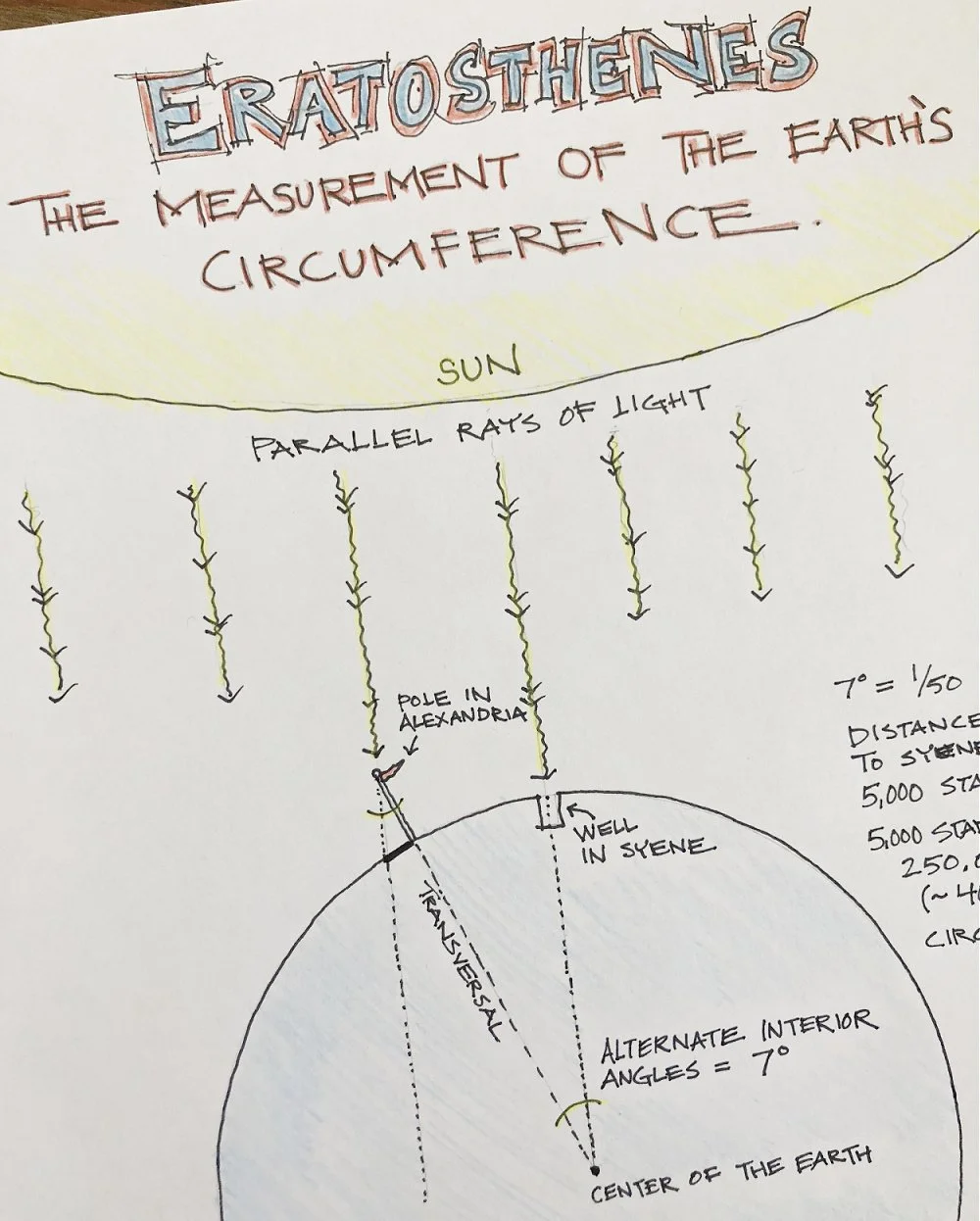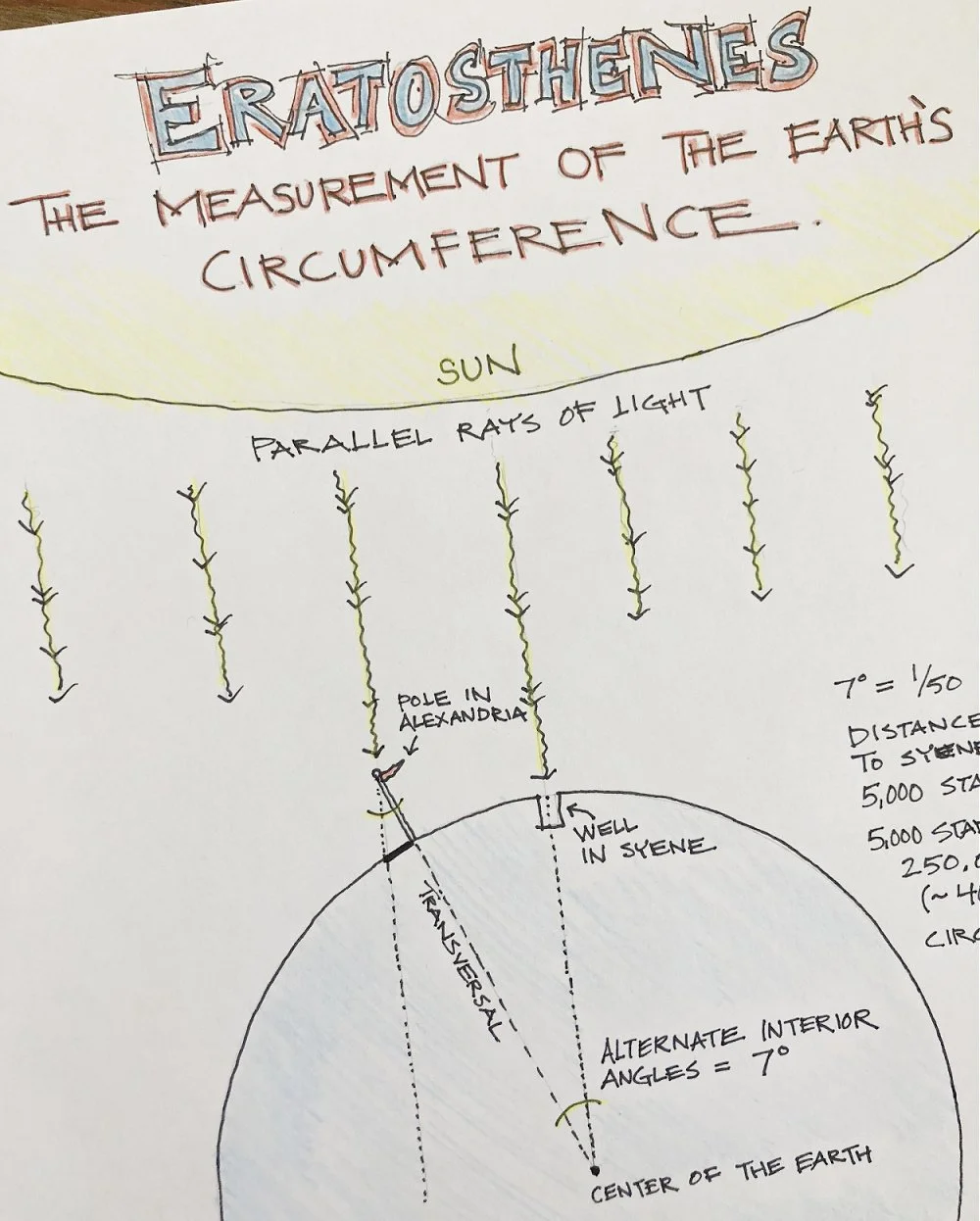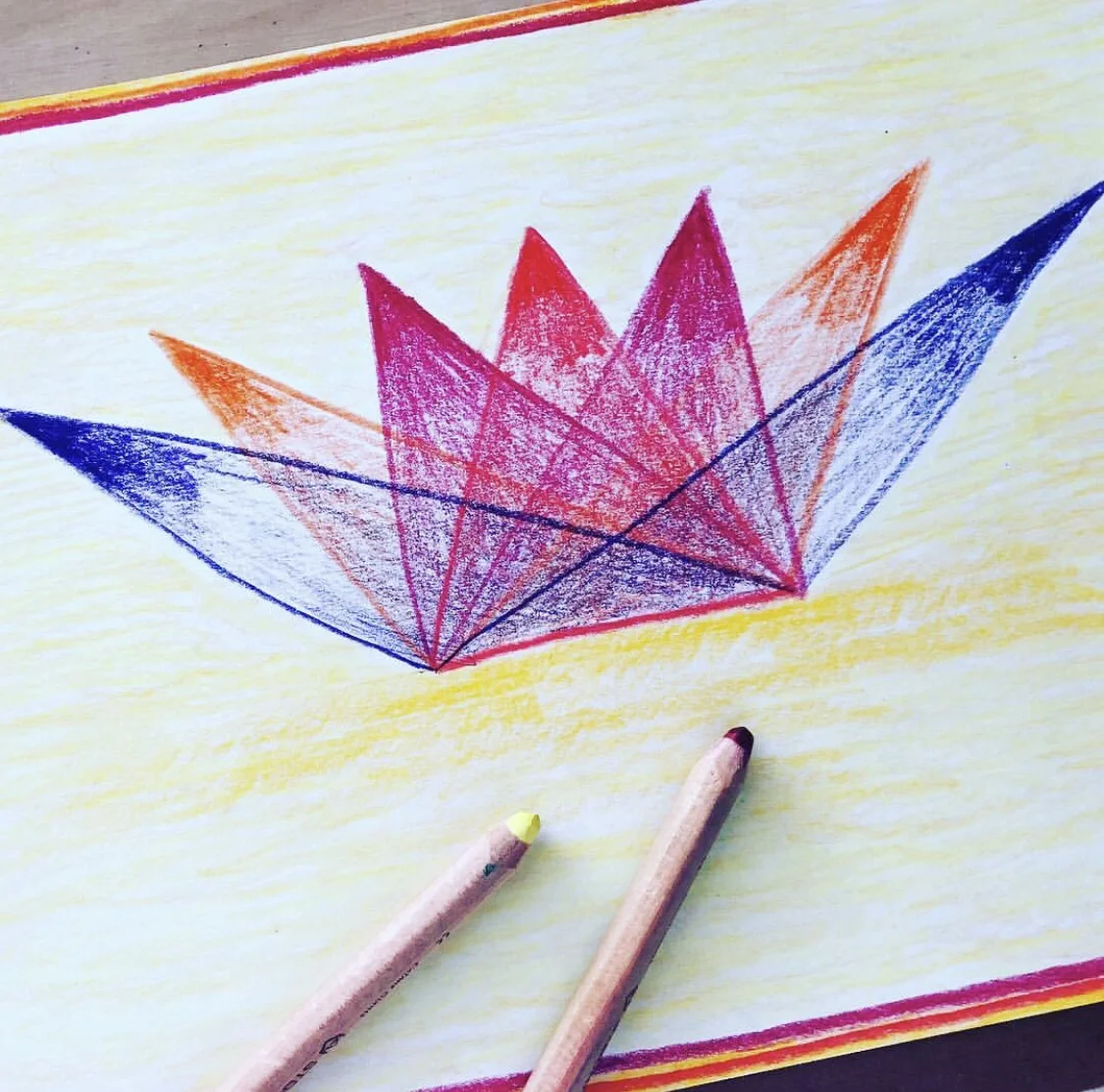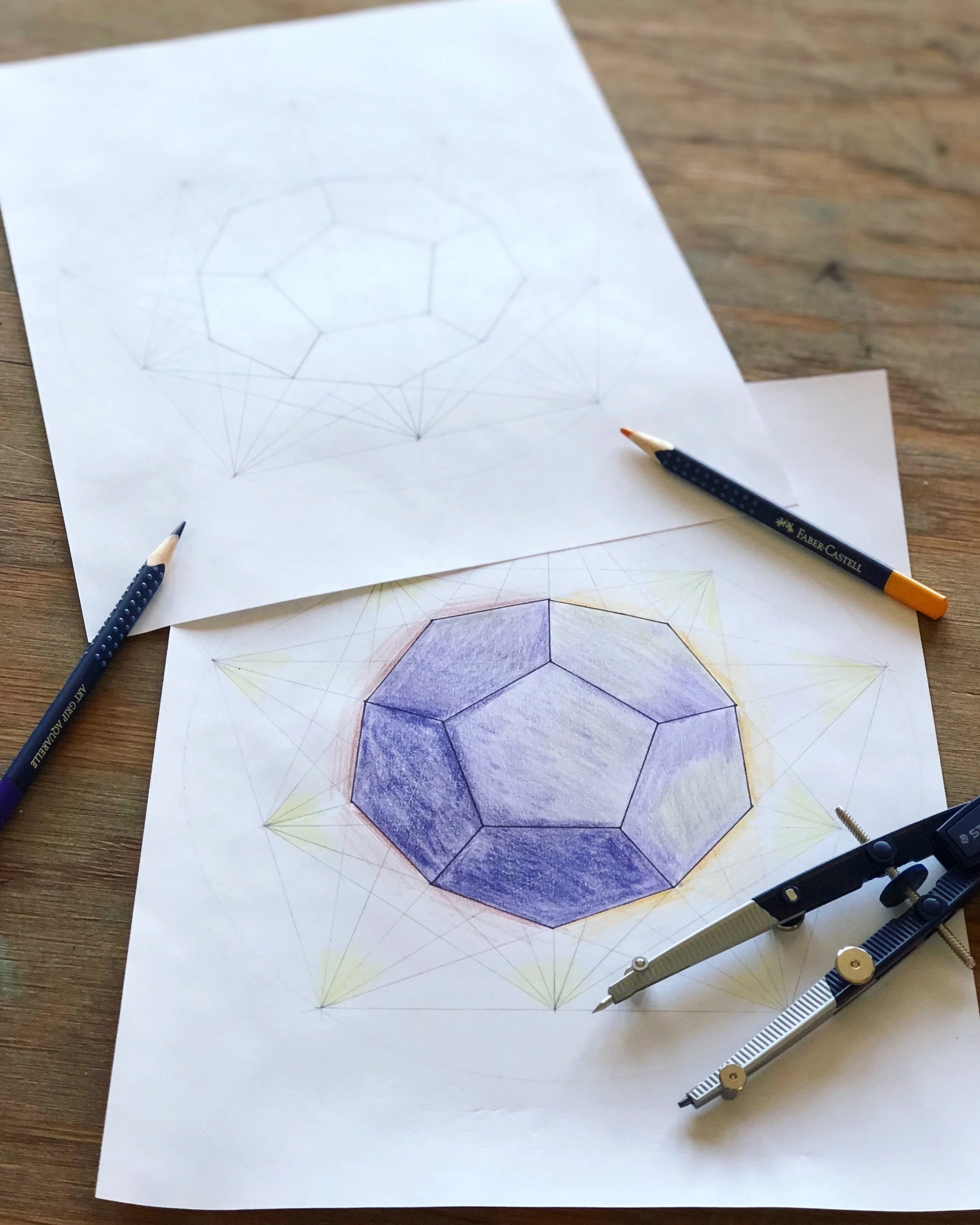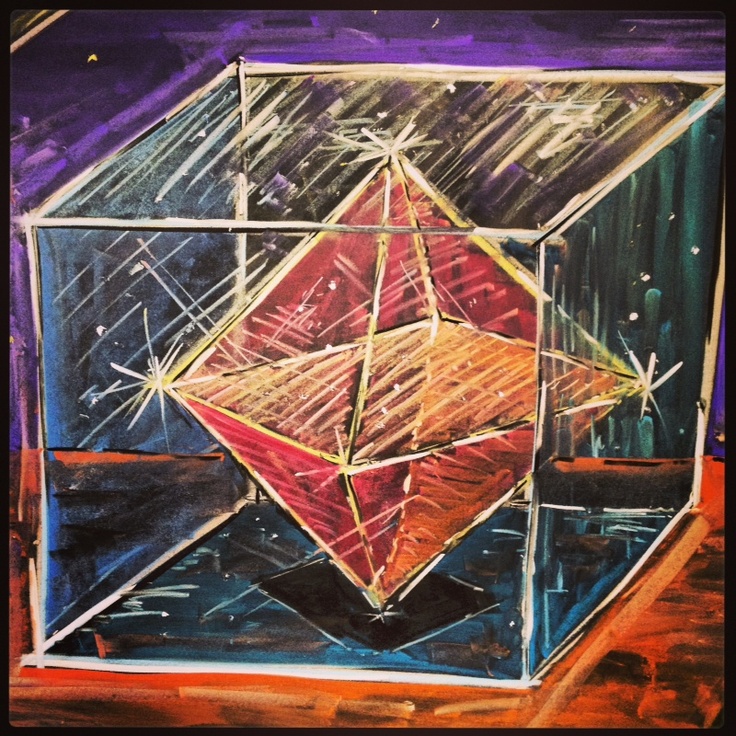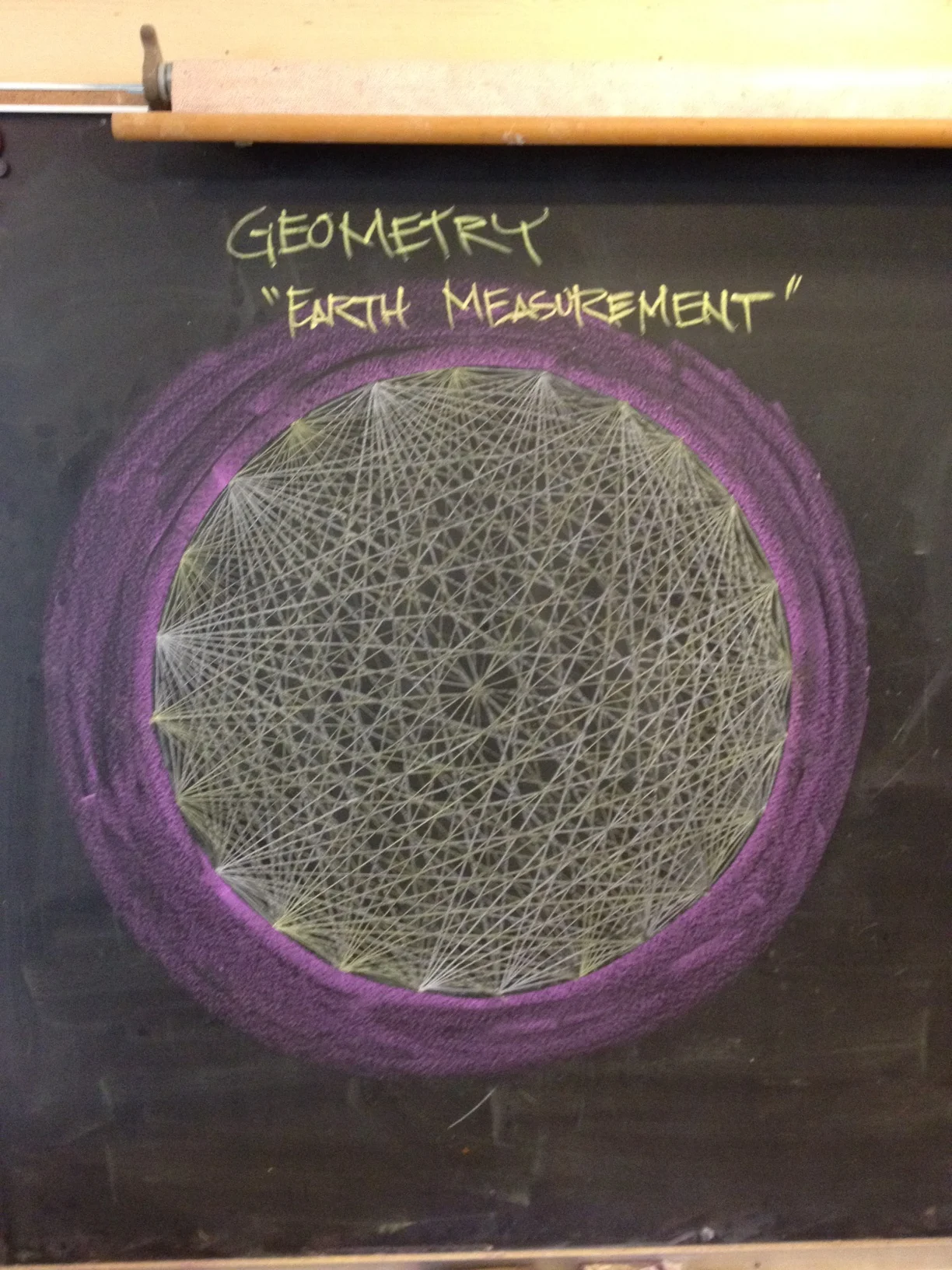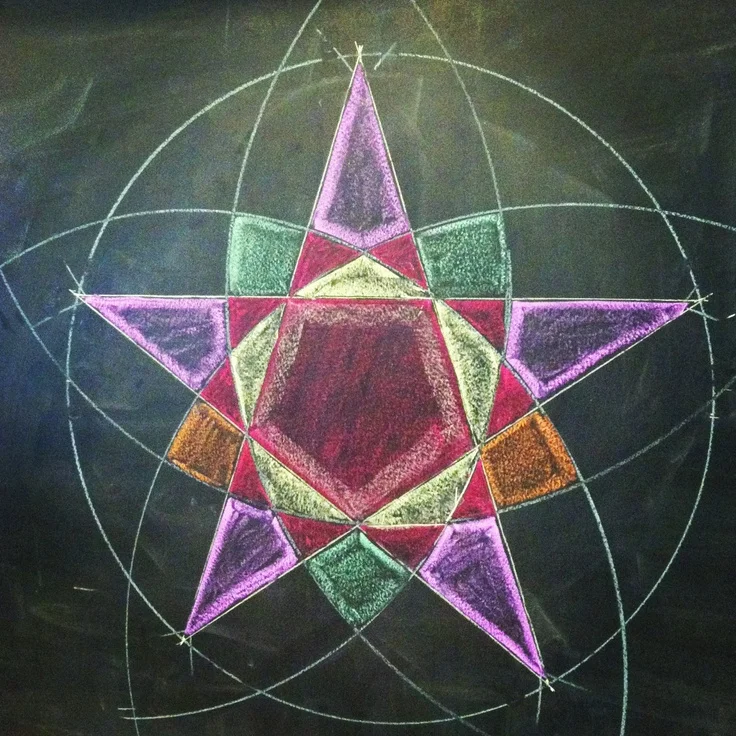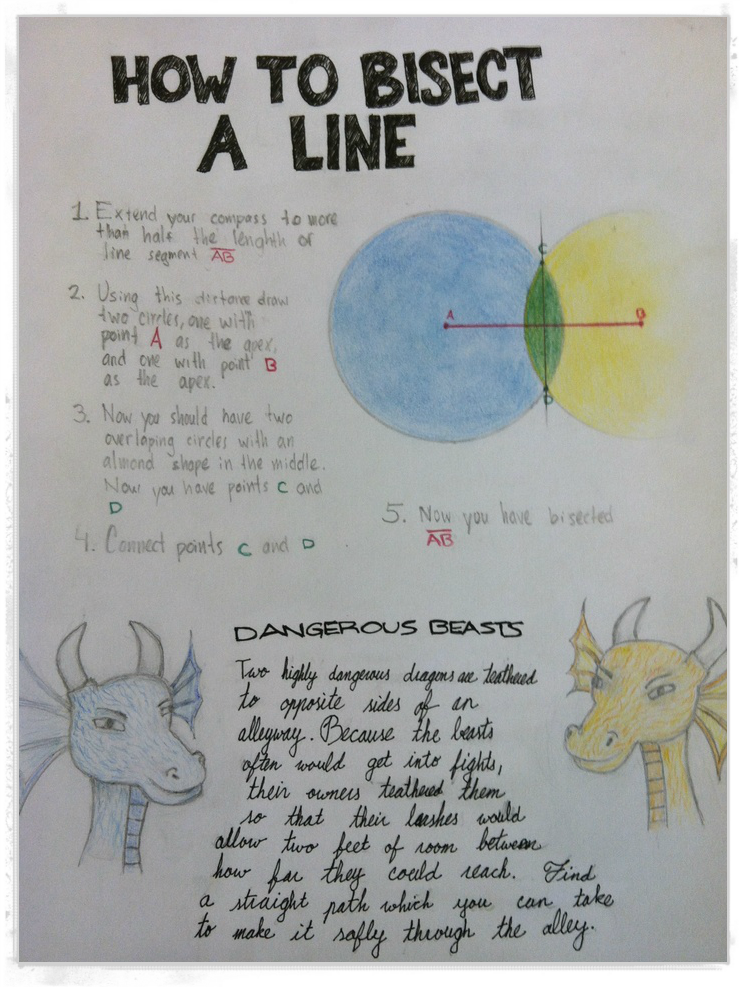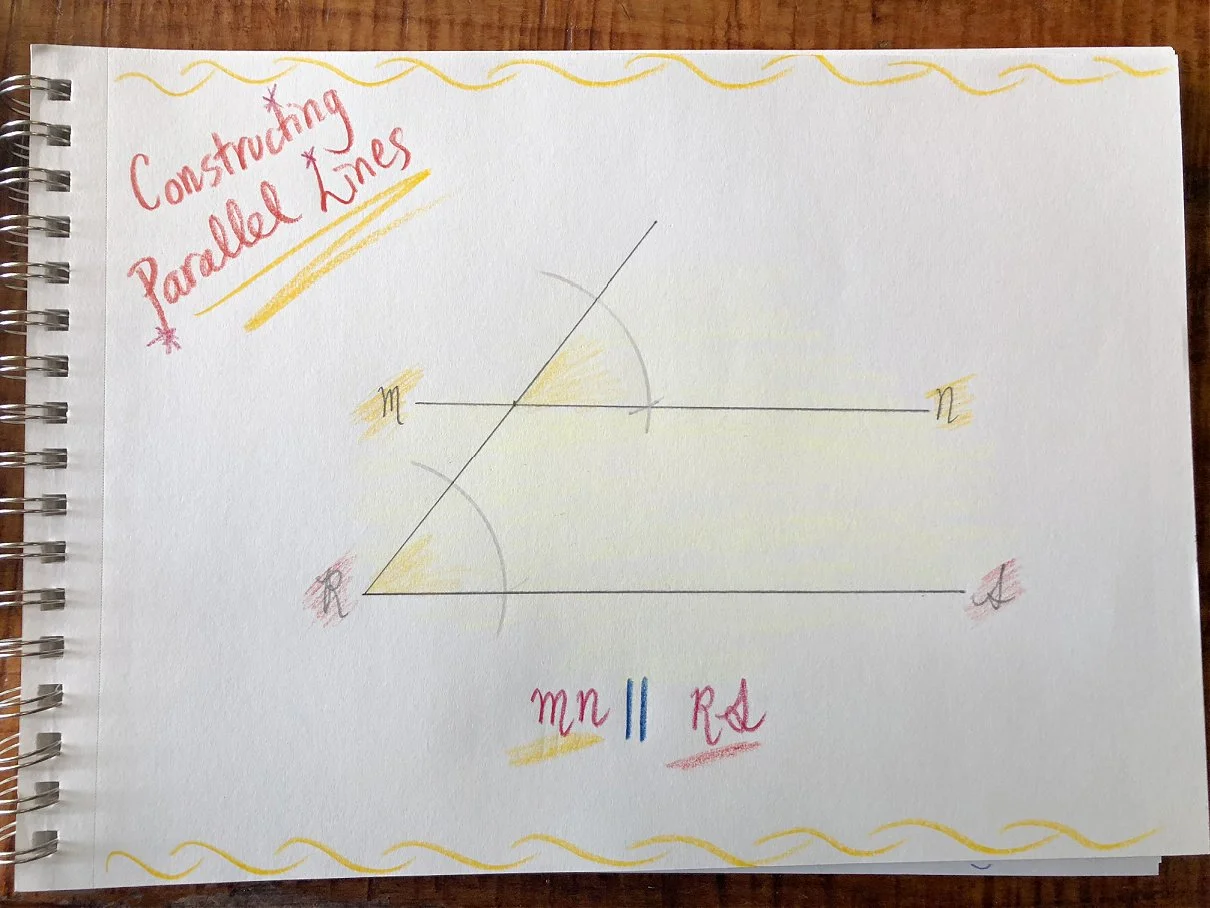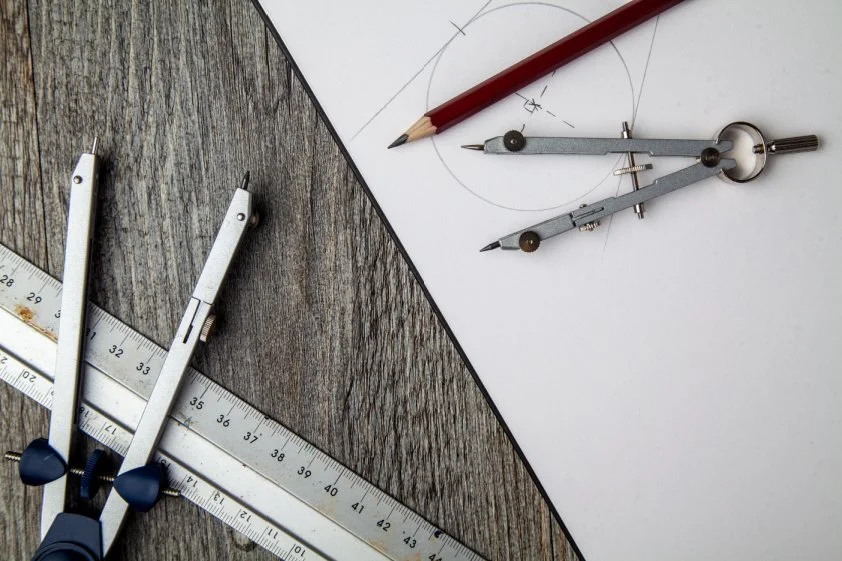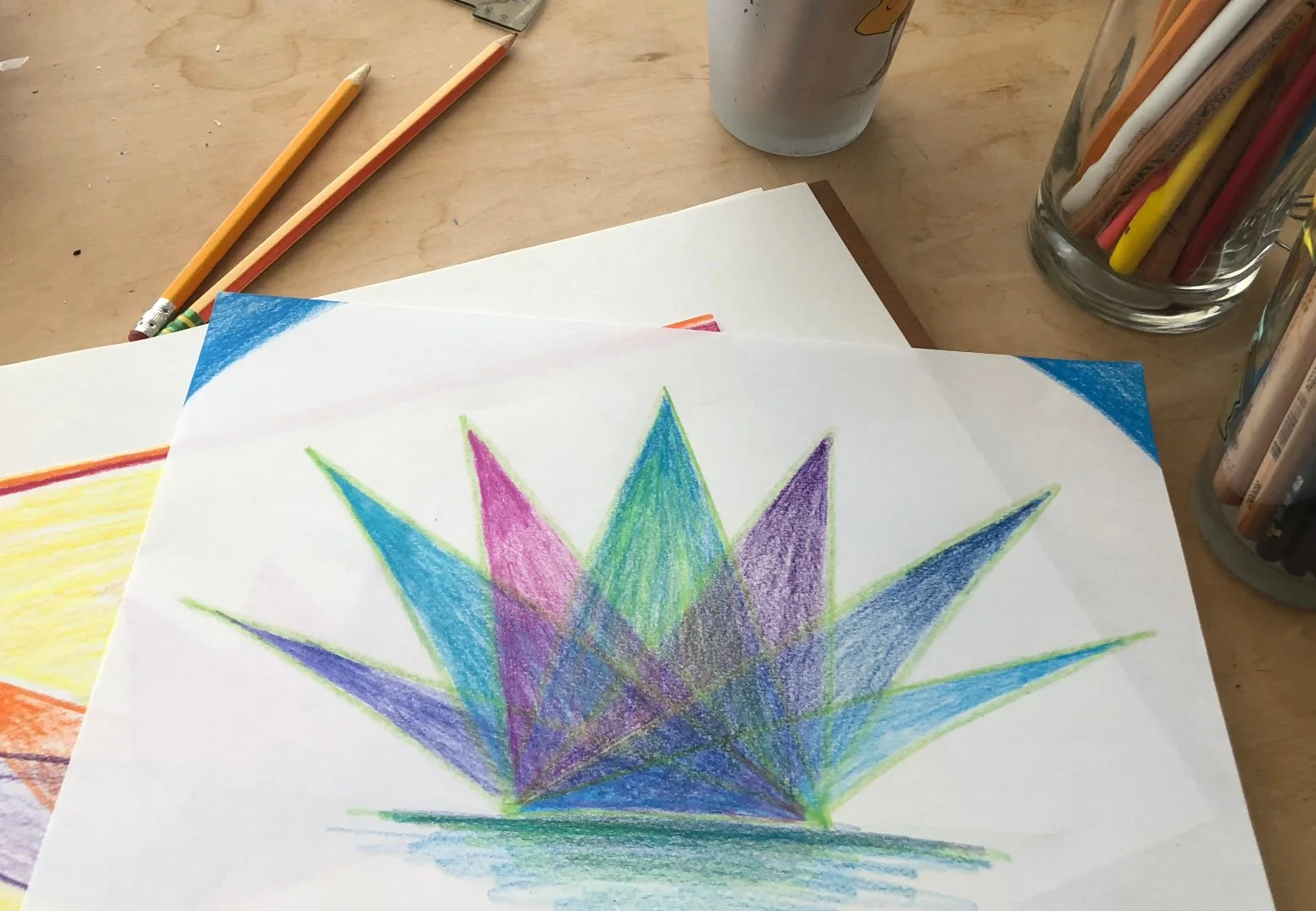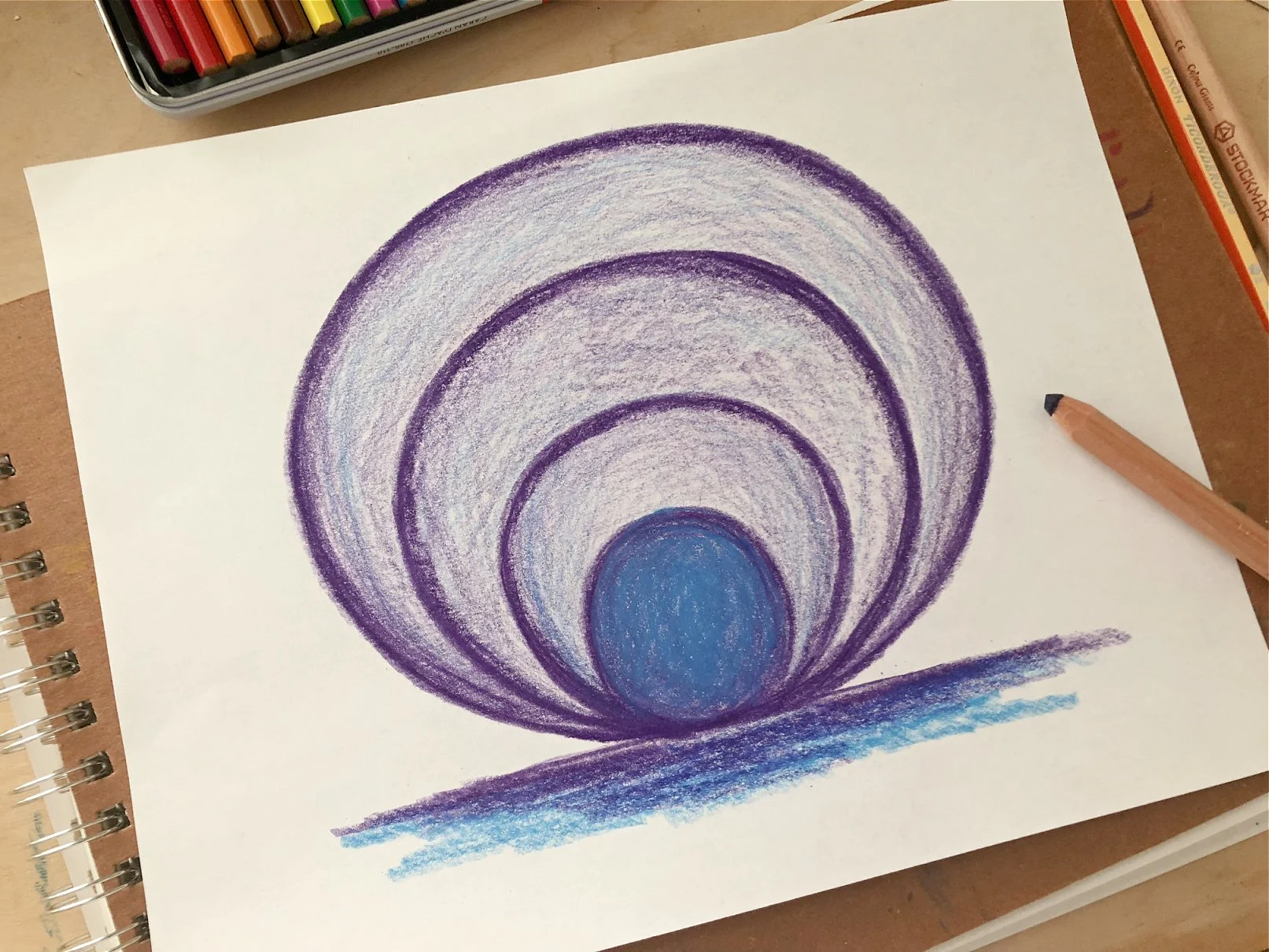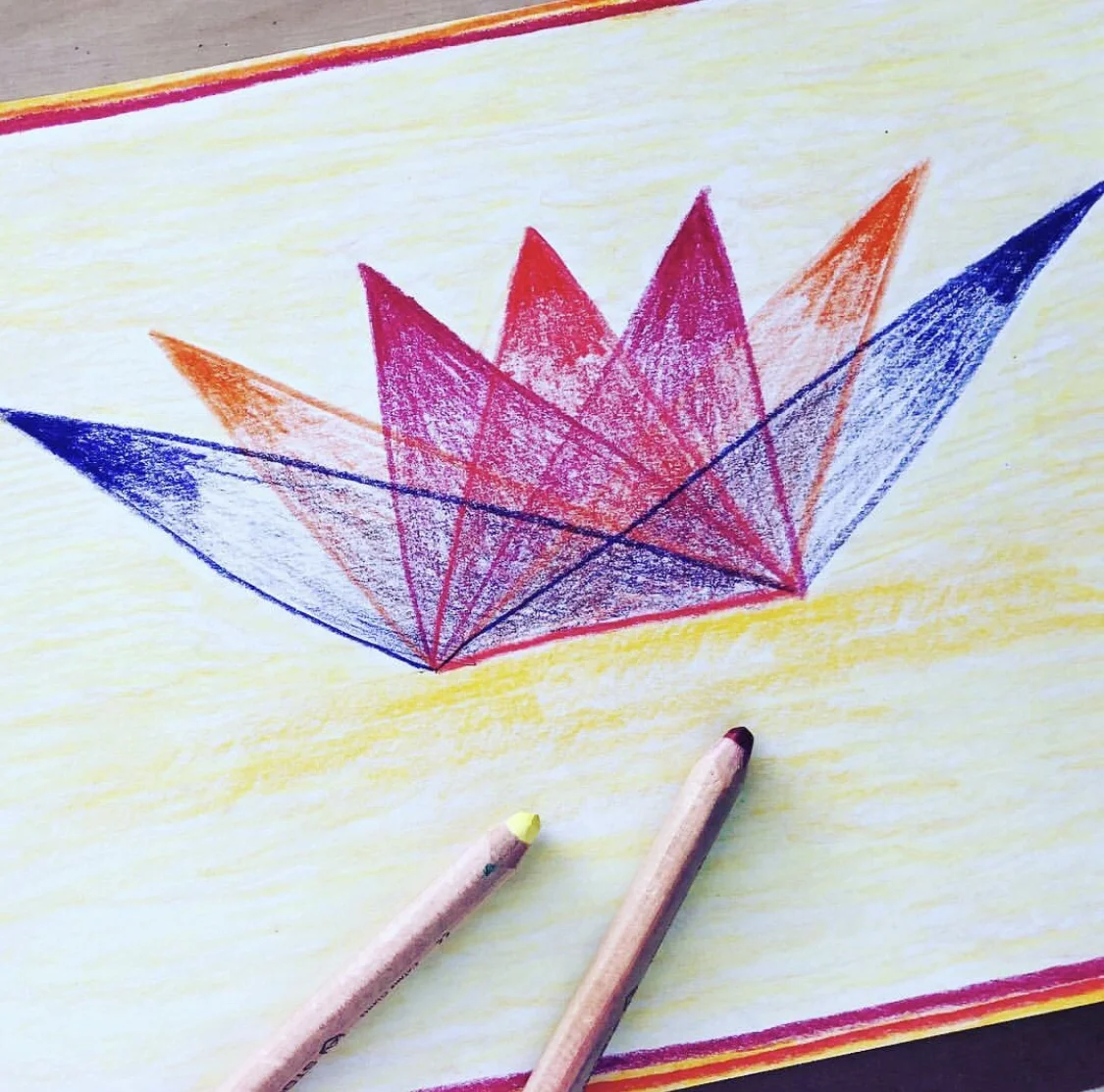
Waldorfish Blog
Why Seventh Grade Geometry in Waldorf Education is So Much More Than Math
In Waldorf education, seventh grade marks a time of profound transformation. The child is entering adolescence - curious, questioning, and more emotionally aware than ever before.
Example work from Grade Seven Geometry curriculum.
It’s a phase where students begin to look both inward and outward with new intensity, seeking meaning, structure, and truth in the world around them.
This is precisely why the seventh grade geometry curriculum is such a perfect fit: it weaves together logic and beauty, discovery and structure, the artistic and the analytical.
Geometry in seventh grade builds on the strong foundation laid in earlier years. In fifth and sixth grade, students explored the natural forms of geometry - think of the hexagons in a beehive or the spirals of a sunflower - while gaining comfort using a compass and straightedge. They practiced freehand constructions that mirrored the work of the Ancient Greeks, and they learned to appreciate geometry not as abstract math but as a living language of form and proportion.
Now, in seventh grade, the curriculum deepens and expands. Geometry becomes a journey of exploration - across time, culture, and perspective. Students revisit Ancient Greek ideas through the lens of Renaissance artists and architects. They investigate how geometry shows up in the human body (like in Leonardo da Vinci’s Vitruvian Man), in Gothic cathedrals, and in the natural world through phenomena like the Fibonacci sequence. Geometry becomes a kind of time travel - linking the student with thinkers and creators across history.
For example, rather than simply memorizing formulas, a seventh grader might explore area by constructing a golden rectangle using only a compass and straightedge, then identify the golden ratio in pinecones, flower petals, or seashells.
Or they might discover the value of Pi not by being told it's 3.14159… but by physically measuring circles in nature - wrapping string around a tree stump or tracing circular stones - and calculating the ratio of circumference to diameter.
The moment they realize that the answer is always just a little bit more than three is a revelation, especially when they learn that this irrational number continues forever without repeating - just like some of life’s biggest questions.
In Waldorf education, we understand that seventh graders are beginning to see themselves as separate individuals.
They want to test what is true. So it’s no surprise that they take real delight in uncovering geometric truths. Proving the Pythagorean Theorem using ancient visual methods - like drawing squares on the sides of a triangle and physically rearranging them to prove equivalence - gives students a hands-on way to engage in abstract thinking. It shows them that some things can be known, that there are universal laws, and that their own reasoning and observation can uncover them.
Geometry at this stage also encourages discernment and builds trust in one’s own inner capacities. Adolescents are often swimming in a sea of emotion and change, but patterns like those in sacred geometry or the Fibonacci sequence offer grounding and reassurance. Amid the swirling questions of identity and belonging, geometry quietly says: “Some things are constant. Some things make sense.”
And perhaps that’s the greatest gift of seventh-grade geometry in the Waldorf curriculum.
It’s not just about mastering content; it’s about helping students feel connected - to truth, to history, to the natural world, and to their own sense of wonder.
About the Authors
Robyn Beaufoy is Waldorfish’s CEO, and also a course instructor for Simple Season, Waldorf Art for Beginners, and Weekly Art Foundations. You’ll find her intuitive touches and influences throughout everything Waldorfish offers. Robyn has been in the world of education for over 25 years, with an MA in Education and a certification in Waldorf teaching - she also homeschooled both of her children for some of that time. In 2012 Robyn co-founded Waldorfish.com, creating it with the vision of making Waldorf inspired-art and pedagogy more accessible, joyful, and doable for homeschoolers all over the world.
Caitlin Amajor is Waldorfish’s course instructor for Geometry grades 5 & 6, and Botany, as well as our Administrative Assistant. From a young age, Caitlin has been immersed in Waldorf education, attending a Waldorf school from K-8. After receiving a BA in History, Caitlin gained her certification in Waldorf teaching, and spent seven years as a Waldorf class teacher in the upper grades. With a special fondness for watercolor painting and geometry, Caitlin loves bringing Waldorf education to her students all over the world, and seeing their own individuality and style bloom from the curriculum!
Waldorf Geometry: Why Do We Wait Until Sixth Grade to Introduce Tools?
Q: Why does Waldorf Geometry wait until grade six to introduce the compass and straightedge?
(This post is part of a series in which we answer the most common questions we receive in our inbox re: homeschooling, Waldorf curriculum/pedagogy, and whatever else comes our way! Click here to read more from the series!)
A: Waldorf education approaches geometry differently than other pedagogies, especially when it comes to the progression of how the material is presented and explored.
One of the primary ways that Waldorf geometry curriculum sets itself apart from other methods, is in the fact that we wait to introduce the compass and straightedge until the sixth grade.
Why? It all goes back to where the child is in their development!
Though simple, geometry tools help to create intricate, varied forms!
To explore sixth grade geometry, we first need to take a step back to fifth grade. The fifth grader is in a very special place in their development. They are experiencing a time of true balance in their physical body, and are still connected with the more mystical and magical aspects of the natural world, while beginning to explore the realities of the world in which they live.
Fifth grade geometry is designed to meet the child right where they’re at in this unique phase of development.
The geometry curriculum is explored using only freehand techniques, (no tools quite yet!) which allows the student to utilize their sense of balance, symmetry and appreciation of beauty all through the lens of geometry. Working freehand allows the child to truly connect on a deep, soul level with the forms; their ability to draw, create, and apply their skills in geometry comes only from within, independent of outside influence or assistance.
When a student enters into sixth grade, everything is beginning to change. They are entering puberty, meaning their emotional and physical being is in flux, and they are often ready for new and more challenging ways to learn.
It’s the perfect time to bring tools into the geometry curriculum: a straightedge for the lines, and a compass for the arcs!
A geometry form in progress- all created with a compass and straightedge!
The sixth grader craves a new way of learning, a different way of being challenged, and is looking for order in the new chaos they are experiencing inwardly. The geometric tools provide this experience in deeply impacting and meaningful ways.
With the compass and straightedge, the sixth grader is able to create forms that are precise, orderly, and follow a certain set of rules that are true not only on their paper, but in the whole of the natural world. They have explored these rules in fifth grade, but in a more artistic, free way, and now, they are ready to add in the tools to find a new, more precise perspective on geometry.
Because the student has already explored geometry in fifth grade, the sixth grader does not rely on the tools, instead, tools are used as a way to deepen and enhance their understanding of the vast world of geometry.
As the student is changing, so too must the curriculum, and sixth grade is the perfect time to bring in the addition of tools to geometry. The compass and straightedge, though seemingly simple, provide a vehicle for the student to further their exploration into geometry, and therefore, their exploration into the whole world- mathematics, biology, chemistry, art history - geometry is truly found in everything!
More of your questions answered below!
About the Authors
Robyn Beaufoy is Waldorfish’s CEO, and also a course instructor for Simple Season (coming soon!), Waldorf Art for Beginners, and Weekly Art Foundations. You’ll find her intuitive touches and influences throughout everything Waldorfish offers. Robyn has been in the world of education for over 25 years, with an MA in Education and a certification in Waldorf teaching - she also homeschooled both of her children for some of that time. In 2012 Robyn co-founded Waldorfish.com, creating it with the vision of making Waldorf inspired-art and pedagogy more accessible, joyful, and doable for homeschoolers all over the world.
Caitlin Amajor is Waldorfish’s course instructor for Geometry grades 5 & 6, and Botany, as well as our Administrative Assistant. From a young age, Caitlin has been immersed in Waldorf education, attending a Waldorf school from K-8. After receiving a BA in History, Caitlin gained her certification in Waldorf teaching, and spent seven years as a Waldorf class teacher in the upper grades. With a special fondness for watercolor painting and geometry, Caitlin loves bringing Waldorf education to her students all over the world, and seeing their own individuality and style bloom from the curriculum!
Waldorf Geometry: How can I incorporate art into a traditional geometry curriculum?
Q: How can an artistic Waldorf geometry curriculum be a supplement to a more traditional geometry curriculum?
(This post is part of a series in which we answer the most common questions we receive in our inbox re: homeschooling, Waldorf curriculum/pedagogy, and whatever else comes our way! Click here to read parts one and two!)
A: Think back on your experience with geometry in middle school or high school; what do you remember? Most likely, your experience was full of a lot of calculations, proofs, and formulas. There probably wasn’t a lot of color or drawing involved, and we’re guessing that overall, it probably just felt like a lot of math.
Sound familiar?
This “right angle spiral” form can be found in our sixth grade geometry course- the shading possibilities are endless!
Don’t get us wrong, geometry does and (and must!) include all of the aspects we noted above; geometry is an incredibly important cornerstone of the study of mathematics. But through Waldorf education’s approach to geometry, the curriculum transforms into a study of mathematics in an artistic, well-rounded way- it’s where art meets math!
You may have heard that in Waldorf education, the educator’s task is to “enliven” the curriculum, so that the growing child can connect with the material deeply and in a multifaceted way.
For geometry, this can be achieved by weaving in beauty, color, and an appreciation of geometric law wherever possible.
(Don’t worry, it’s much less complicated than it may seem!)
For example, in eighth grade, students are introduced to 3D forms; polyhedrons called “Platonic Solids” (to learn more, click here!). Not only will the students learn to calculate the volume of these forms, but they will also take time to really understand them through an artistic lens.
A common activity with these 3D shapes is to draw them in 2D form on paper, almost like a blueprint of what it will become. From there, the students will construct these shapes carefully, using beautiful paper, often painted or beautifully shaded to celebrate each platonic solid.
This activity asks the student to build their sense of spatial awareness, deepen their understanding of geometric law, improve upon their precision and accuracy, develop their ability to think abstractly, and much more.
Walk into a Waldorf eighth grade classroom, and you are likely to see the platonic solids displayed proudly.
Even a simple construction of parallel lines can include artistic elements!
In sixth grade, a large part of the Waldorf geometry curriculum is constructing polygons and learning vocabulary and definitions for each. How would one define a square as compared to a rectangle? Or, a trapezoid to a quadrilateral?
Each is studied carefully, and the student learns to construct these shapes using the compass and straightedge in the most accurate way possible.
Through the construction process, the student not only learns how to use the tools, but they also connect with the vocabulary in a very real, physical way. They are building the shapes themselves, feeling the symmetry(or lack thereof) and striving to improve upon their skills.
Again, an artistic approach to learning geometry vocabulary builds connection to the subject itself.
It is not something one just reads about, but it is something one does.
Geometry is a rich subject, and through Waldorf education, the subject retains its sense of wonder, connection to nature, and celebration of beauty while building important skills in math calculation and critical thinking.
About the Authors
Robyn Beaufoy is Waldorfish’s CEO, and a course instructor. You’ll find her intuitive touches and influences throughout everything Waldorfish offers! Robyn has been in the world of education for over 25 years, with an MA in Education and a certification in Waldorf teaching - she also homeschooled both of her children. In 2012 Robyn co-founded Waldorfish.com, creating it with the vision of making Waldorf inspired-art and pedagogy more accessible, joyful, and doable to homeschoolers all over the world.
Caitlin Amajor is Waldorfish’s course instructor for Geometry grades 5 & 6, and Botany, as well as our Administrative Assistant. From a young age, Caitlin has been immersed in Waldorf education, attending a Waldorf school from K-8. After receiving a BA in History, Caitlin gained her certification in Waldorf teaching, and spent seven years as a Waldorf class teacher in the upper grades. With a special fondness for watercolor painting and geometry, Caitlin loves bringing Waldorf education to her students all over the world, and seeing their own individuality and style bloom from the curriculum!
More for you to enjoy!
December update
*Early-bird registration - Waldorf Homeschooling Conference
Join us in Atlanta, GA March 8th & 9th! We'll be leading 4 workshop sessions at this regional event, covering Geometry, Movement, Watercolor painting, and Chalk Drawing.
Read more about all the workshops & teachers, plus take advantage of early-bird pricing, which ends Dec 31st.
*Waldorfish Families interview series
Every few weeks on the blog we are shining a spotlight on different families from within the Waldorfish community! You are such a diverse and global group - we're pretty sure you'd be bff's in real life. Please enjoy this conversation with Jessica Richardson! She shares a few of her family's favorite resources, as well as some words of wisdom:
"I've learned to let go of perfect, to not expect myself to be able to teach every subject, and to not go it alone. Allowing others, like using the Waldorfish Geometry, gives me a break from planning so I can place attention somewhere else. My best advice is to create a local Waldorf inspired group to meet with weekly for nature walks, festivals, and seasonal fun. Ours is finally thriving and my children and I are so happy when we meet!"
Click here to read the full interview.
*Weekly Art enrollment will close on Jan 15th
For those who would still like to join us for this year's session, the deadline for enrollment is January 15th. Click here to join us
(P.S. if you plan to use charter school funds for this course, please send your PO now!)
In January we will begin the process of dreaming up the new 2019/'20 session of Weekly Art lessons!
*New Geometry Sample Lesson
We've replaced our free geometry sample lesson with something new! Pulled from the Grade 5 course, this freehand exercise will give you a good feel for how all the lessons in the full program are filmed, and how they flow.
We've also included a brief intro video from each of the grades 5-8, outlining what each course covers.
Scroll down to the bottom of this page, and tell us where to send your free lesson!
Looking for something?
Welcome to Waldorfish! We started this adventure in 2012 out of a desire to make Waldorf training more accessible to class teachers in remote locations and to homeschooling families everywhere! Read more, click here.
WE WON! Our Weekly Art courses were voted “best interactive art program.” Learn more about the award, here.
A few of our most popular blog posts:
